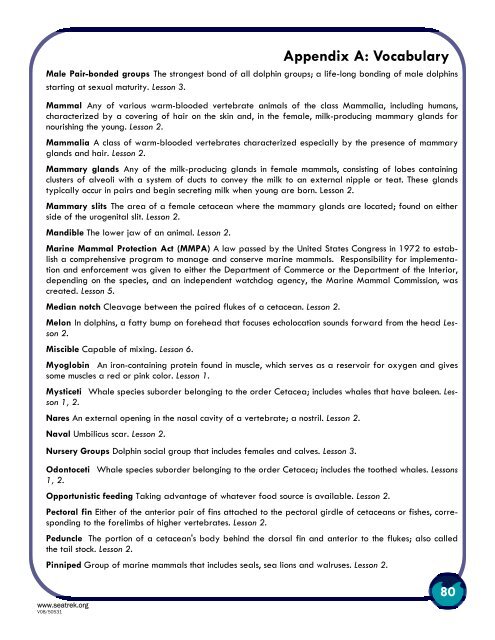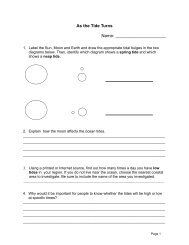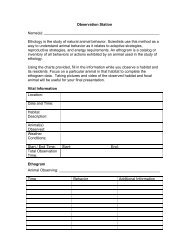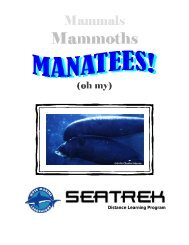LESSON 2 - SeaTrek Programs
LESSON 2 - SeaTrek Programs
LESSON 2 - SeaTrek Programs
Create successful ePaper yourself
Turn your PDF publications into a flip-book with our unique Google optimized e-Paper software.
Appendix A: Vocabulary<br />
Male Pair-bonded groups The strongest bond of all dolphin groups; a life-long bonding of male dolphins<br />
starting at sexual maturity. Lesson 3.<br />
Mammal Any of various warm-blooded vertebrate animals of the class Mammalia, including humans,<br />
characterized by a covering of hair on the skin and, in the female, milk-producing mammary glands for<br />
nourishing the young. Lesson 2.<br />
Mammalia A class of warm-blooded vertebrates characterized especially by the presence of mammary<br />
glands and hair. Lesson 2.<br />
Mammary glands Any of the milk-producing glands in female mammals, consisting of lobes containing<br />
clusters of alveoli with a system of ducts to convey the milk to an external nipple or teat. These glands<br />
typically occur in pairs and begin secreting milk when young are born. Lesson 2.<br />
Mammary slits The area of a female cetacean where the mammary glands are located; found on either<br />
side of the urogenital slit. Lesson 2.<br />
Mandible The lower jaw of an animal. Lesson 2.<br />
Marine Mammal Protection Act (MMPA) A law passed by the United States Congress in 1972 to establish<br />
a comprehensive program to manage and conserve marine mammals. Responsibility for implementation<br />
and enforcement was given to either the Department of Commerce or the Department of the Interior,<br />
depending on the species, and an independent watchdog agency, the Marine Mammal Commission, was<br />
created. Lesson 5.<br />
Median notch Cleavage between the paired flukes of a cetacean. Lesson 2.<br />
Melon In dolphins, a fatty bump on forehead that focuses echolocation sounds forward from the head Lesson<br />
2.<br />
Miscible Capable of mixing. Lesson 6.<br />
Myoglobin An iron-containing protein found in muscle, which serves as a reservoir for oxygen and gives<br />
some muscles a red or pink color. Lesson 1.<br />
Mysticeti Whale species suborder belonging to the order Cetacea; includes whales that have baleen. Lesson<br />
1, 2.<br />
Nares An external opening in the nasal cavity of a vertebrate; a nostril. Lesson 2.<br />
Naval Umbilicus scar. Lesson 2.<br />
Nursery Groups Dolphin social group that includes females and calves. Lesson 3.<br />
Odontoceti Whale species suborder belonging to the order Cetacea; includes the toothed whales. Lessons<br />
1, 2.<br />
Opportunistic feeding Taking advantage of whatever food source is available. Lesson 2.<br />
Pectoral fin Either of the anterior pair of fins attached to the pectoral girdle of cetaceans or fishes, corresponding<br />
to the forelimbs of higher vertebrates. Lesson 2.<br />
Peduncle The portion of a cetacean's body behind the dorsal fin and anterior to the flukes; also called<br />
the tail stock. Lesson 2.<br />
Pinniped Group of marine mammals that includes seals, sea lions and walruses. Lesson 2.<br />
www.seatrek.org<br />
V08/50531<br />
80





